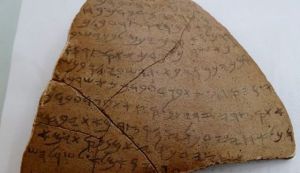
A potsherd, or pottery shard, containing a written message in Hebrew. Potsherds with writing are also called ostracons.
Another argument, popular with anti-Christian authors, is that Jesus was very likely an illiterate peasant. If Jesus was illiterate, they assert, then the New Testament accounts of him referring to scripture and generally stumping the Jewish Pharisees in debates are suspect, and not to be trusted. This argument is most recently articulated by Reza Aslan in his book, Zealot: The Life and Times of Jesus of Nazareth.
Aslan argues that the vast majority of people in Jesus’ world—about 98%–were illiterate. In his mind, so was Jesus. When one digs below the surface, however, it becomes evident that Aslan is likely mistaken.
The Backdrop
As we dig into this, let’s take a minute to understand the context. The region of the world in which Jesus lived, worked, and preached was not the backwater that many assert it was. In fact, the area had been thoroughly Hellenized since the time of Alexander the Great, centuries before. Greek influence was strong. As a result, Greek was widely spoken as a first or second language. The primary language of Jesus and other Palestinian Jews was Aramaic. However, it’s likely that Jesus—and most other Jews—also spoke at least some Greek. We have written before in this blog that a significant amount of bilingualism existed in Palestine during the first century.
It’s also important to note that Jesus was not a peasant. He was a “tekton,” or carpenter. Whether Jesus primarily worked in wood or stone is open to debate, but it’s likely he was involved in working with both. His family had a home, he had a trade, and he did not fit the commonly understood definition of a peasant.
He is said to have come from the small village (at the time) of Nazareth. Less than 4 miles away was the heavily Romanized city of Sepphoris, a much larger and far more cosmopolitan place than Nazareth. During the first part of the first century, Sepphoris saw a lot of building and expansion, and it’s likely there that Jesus performed most of his carpentry or masonry work.
Literacy in Jesus’ World
One of the definitive works on literacy in Palestine during the Gospel period is Reading and Writing in the Time of Jesus, by Alan Millard. Millard is Rankin Professor Emeritus of Hebrew and Ancient Semitic Languages, and Honorary Senior Fellow at the School of Archaeology, Classics, and Egyptology in the University of Liverpool. During his career, he has worked on archeological excavations in Syria, Jordan, and Iraq.
He asserts that “archaeological discoveries and other lines of research show…writing and reading were widely practiced in Jesus’s day.” This is a direct contradiction of Aslan’s claims.
There is limited space in this one article to fully unpack Millard’s evidence, but we can share a few key pieces:
- There was a strong tradition of literacy among Jews, particularly males, as they were taught to read the Torah. Each would have to read from the Torah at their synagogue. This education, while not benefiting all Jewish males, was certainly not limited to the upper-class elites. Jesus, being from a devout Jewish family, would likely have been taught to read the Torah.
- Multi-lingual inscriptions have been found throughout the region, dating from the proper periods (third century BC through the first century A.D.). They bear Aramaic and Greek writing, some with half of a message in Greek and half in Aramaic. This attests to the likely bilingualism that existed there. These include survey, burial, and building inscriptions.
- Multi-lingual coins were also issued, such as those of the Judean king, Alexander Jannaeus (ruled 103 B.C.-76 B.C.).
- Weights and measures in Jerusalem were Greek, again attesting to the bilingualism that existed.
- Potsherds, which are pottery fragments containing writing, have been found in Greek and in Aramaic.
- Greek texts have been found, such as those in Qumran Cave 7.
- Masonry markings, written in Greek and in Aramaic, have been found on stone columns in Masada and in other areas. Masons and carpenters needed to know how to write—at least to some extent—to do their jobs. This would have included Jesus.
This article is not intended to imply that most Jews in first century Palestine could read and write. However, it is likely that literacy rates were far higher than Aslan and some others assert. Regarding Jesus’ literacy, the burden of proof rests squarely on those who would deny it. The available evidence indicates that He could read and could possibly write, at least to a certain extent. The same would have been true of many of Jesus’ disciples.

Why would anyone think God as Man (creator of all) couldn’t read